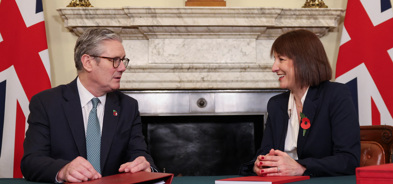Sterling rebounded as Brexit outlook softened – weekly update 28 January
A look back over macroeconomic and market events for the week ending 25 January 2019.
The value of investments can fall as well as rise and that you may not get back the amount you originally invested.
Nothing in these briefings is intended to constitute advice or a recommendation and you should not take any investment decision based on their content.
Any opinions expressed may change or have already changed.
Written by Ben Seager-Scott
Published on 28 Jan 20197 minute read

Sterling rebounded as the Brexit outlook softened, while the Eurozone economy continues to look challenged, and the latest GDP data for China confirmed the slowdown trajectory. It’s a busy week ahead, both for data and politics, so plenty to keep an eye on.
UK Government
It was a surprisingly good week for the UK Government. Despite effectively re-presenting Brexit Plan A with some very minor tweaking, there appeared to be growing support, albeit reluctantly, from Conservative Brexiteers, as the only apparent majority in Parliament seems to be against a no-deal Brexit. The result is that the current balance appears to be between two relatively soft forms of Brexit: Prime Minister Theresa May’s Brexit deal or delaying Brexit altogether, which helped buoy sterling last week.
There was also some encouraging economic data, with Average Weekly Earnings growth picking up from 3.3% to 3.4% year on year (yoy, no change was expected), and unemployment falling from 4.1% to 4.0% (no change was expected).
Eurozone continued to struggle
The Eurozone continued to struggle with the Composite PMI reading unexpectedly falling from 51.1 to 50.7 (an increase to 51.4 was expected). The on-going protests in France once again had an impact, but the damage was somewhat broader, as the German Manufacturing PMI fell marginally into contraction territory, down from 51.5 to 49.9 (no change was expected) on the back of weakness in the autos sector. On the back of this, the European Central Bank (ECB) left monetary policy unchanged and aside from ECB President Mario Draghi commenting about risks having “moved to the downside” the Bank chose to play for time, not giving any significant guidance on replacement loan facilities (TLTRO) or potential technical changes in rates as some had speculated. It seems fair to expect more from the next meeting in March, where updated economic forecasts could help frame the discussion.
Chinese GDP slowed
Chinese GDP slowed to 6.4% yoy in the fourth quarter, down from 6.5% but in line with economic forecasts and coherent with the outlook for a managed slow-down of the world’s second-largest economy. Full-year GDP in 2018 was 6.6% as expected, down from 6.7%. Aside from that, the batch data were reasonably solid, as Retail Sales for December picked up from 8.1% to 8.2% yoy (no change was expected), and Industrial Production growth accelerated from 5.4% to 5.7% yoy (a slip to 5.3% had been expected). Fixed Asset Investment growth held steady at 5.9% yoy, though markets were looking for a slight pick-up to 6.0%. As we have highlighted previously, we believe we will continue to see the Chinese government allow its economy to cool with targeted stimulus measures used to manage the process.
US Government shutdown
It is not particularly clear what’s happening in the US economy given the government shut-down, with US Durable Goods the latest release to be delayed last week. We did, however, get the latest PMI readings from Markit, which showed a robust bounce back in the Manufacturing PMI reading, which was up over a full point from 53.8 to 54.9 (a marginal cooling to 53.5 was forecast), while the Services PMI was only slightly softer, down from 54.4 to 54.2 (54.0 was expected). With the temporary re-opening of the US government announced over the weekend, we should start to see the backlog of reports flow through, which could make it a pretty busy couple of weeks ahead.
Last week’s other events
- The Rightmove House Price index showed that UK house prices rose 0.4% yoy in January, slowing from 0.7% growth in December. Business Optimism, as reported by the CBI, fell from -16 to -23 (-25 was expected), with the Trends total Orders measure falling from 8 to -1 (5 was forecast)
- In the Eurozone, Consumer Confidence came in at -7.9, though the prior reading was revised down from -6.2 to -8.3
- In Japan, the Central bank left policy unchanged, as expected. Manufacturing PMI fell to 50.0 (from 52.6), and the All Industry Activity Index fell from an upwardly-revised 2.1% to -0.3% month on month (-0.4% was expected)
The markets
Markets continued to show signs of stabilising, though there were some notable moves with the markedly stronger sterling impact UK equity returns and gold rallying at the end of the week.
Equities
UK equities fell -2.0% (MSCI UK) on the back of the stronger pound. Elsewhere, markets started on a sour note, but rallied through the rest of the week. The bounce wasn’t enough to get the US back into positive territory, with the S&P 500 returning -0.2% for the week. Mainland Europe (MSCI Europe ex-UK) retuned 0.5% for the week, while the Japanese TOPIX was up 0.6%. It was another relatively strong week for Emerging Markets, as the MSCI Emerging Markets Index rose 1.4%.
Bonds
Core sovereign bonds continued to find buyers through last week, though there was some mild softening on Friday. 10-year US Treasury yields were down 3 basis points (bps) by the end of th e week to close at 2.76%. 10-year UK gilt yields were 5 bps lower to finish at 1.31% while the equivalent German Bund yields were 7 bps lower to 0.19%.
Commodities
A sharp rally on Friday saw gold break through the US$1,300 mark, closing at US$1,305 per ounce. Copper was marginally stronger closing at US$2.73 per lb while oil was a little weaker, with Brent Crude slipping to US$61.64 per barrel.
Currencies
Sterling’s dramatic (for a developed currency) strengthening was the main story of the week, with the pound gaining 2.5% against the US.
The week ahead
It’s a busy week ahead, with a lot of focus in the US where we have the latest Federal Open Market Committee (FOMC) meeting and first estimate of fourth quarter GDP due out on Wednesday (2.6% annualised from 3.4% expected), Non-Farm Payrolls on Friday (forecast for 165,000 jobs added from a bumper 312,000 reading for December, average hourly earnings forecast as unchanged at 3.2%) and some of the backlogged data from the US government shutdown also expected out, including Retails Sales and Durable Goods. The Eurozone also reports fourth quarter GDP on Thursday (1.2% yoy from 1.6% expected), along with inflation figures from the US and Europe and more PMI numbers due out, see below for the details. Earnings season continues apace, while on the politics front we have further debate and amendments relating to Brexit and US-China trade negotiations all going on through the course of the week. The daily breakdown is as follows:
Monday: It’s a very quiet start to the week with the only data of note being the Chicago Federal Reserve’s National Activity Index and the Dallas Federal Reserve’s Manufacturing Activity index.
Tuesday: Aside from UK politics, the data focus will be on some lightweight releases from the US, including Retail Inventories, and the Conference Board Consumer Confidence and Expectations survey results. Just before midnight, Japan releases the December Retail Sales readings.
Wednesday: The data pick up mid-week. In the UK just after midnight the BRC reports the latest reading of the Shop Price Index, and then later in the early-morning Japan reports Consumer Confidence. Mid-morning, the Eurozone reports business confidence before the afternoon excitement – that is the first estimate of US fourth quarter GDP. The first FOMC meeting of the year also marks a change to having press conferences following every meeting (it was previously every other), and while no change in policy is expected, markets will no doubt listen closely to the press conference in the hope of gaining some insight into the latest Federal Reserve’s thinking.
Thursday: A minute after midnight, UK Consumer Confidence is reported and the Lloyds Business Barometer is also out, and then at 1am China reports official Manufacturing and Non-Manufacturing PMI readings. Japan reports Construction Orders and House Starts just before (most people’s) breakfast time at 5am. Mid-morning, Eurozone fourth quarter GDP is reported (covered above) and then the interest moves to the US in the afternoon, where we have Personal Income and Spending measures as well as PCE inflation (1.7% from 1.8% yoy expected). Closing out the day, Japan reports its jobless rate (no change at 2.5% expected).
Friday: Early in the morning, the private Caixin measure of China Manufacturing PMI is released, with UK Manufacturing PMI released later in the morning (53.5 from 54.2 is forecast). Eurozone CPI is out mid-morning and forecast at 1.4% yoy (from 1.6%) with Core CPI forecast as unchanged at 1.0%. The main event, of course, is the US labour market report – as well as the headlines readings covered above, the details such as the unemployment rate, underemployment rate and the participation rate will all be of interest as well. Later in the afternoon, the latest US Manufacturing PMI from the Institute for Supply Management will be released to see the week out – forecasts are for 54.2 from 54.3.
Get insights and events via email
Receive the latest updates straight to your inbox.
You may also like…


Market news
2024 Autumn Budget Overview: The key announcements from Chancellor Rachel Reeves




